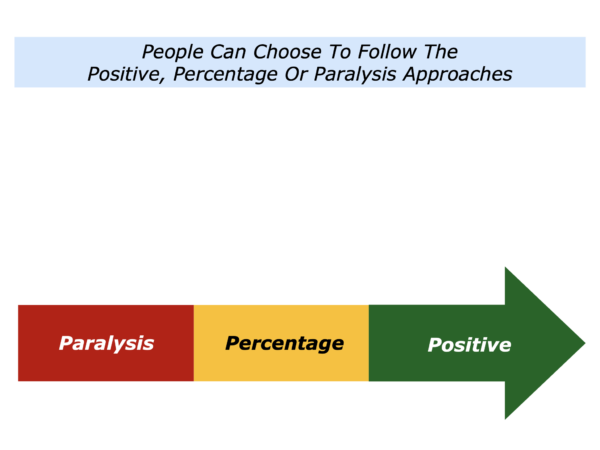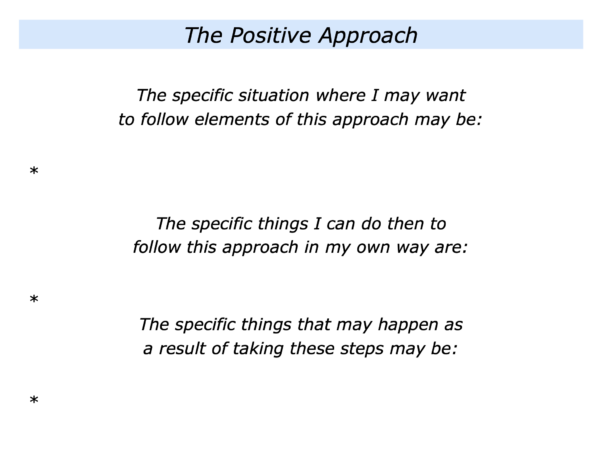
There are many ways to live life. This is a model that is used in sports but it can be applied in many other areas. People can choose to follow the positive, percentage or paralysis approaches in life.
The Positive Approach
A person can choose to be positive and proactive. They can aim to make things happen rather than wait for things to happen.
This is an approach I saw demonstrated when working with sports psychologists. Some coaches encouraged their players to start by clarifying their picture of success.
The key was to help the players to focus what they could control. They could aim to do their personal best but they could not control whether they always won. Going into their version of the arena, the player could be positive, follow their principles and work towards their picture of success.
As in life, sometimes it was okay for the players to take the percentage approach, but it was important to avoid falling into paralysis. The latter approach, such as continually looking at the clock when leading, was a recipe for disaster.
Looking back on your life, when have you taken the positive approach? You may have done this when recovering from an illness, setting up a business, tackling a challenge or doing another activity.
What did you do to take this approach? You may have chosen to have a positive attitude. You may then have set specific goals, clarified your strategy and translated this into a clear action plan.
You may have followed a discipline and, when appropriate, found solutions to challenges. You may then have done your personal best to achieve the picture of success.
Looking ahead, can you think of a situation where you want to take the positive approach? How can you follow similar principles plus maybe add other skills? How can you do your best to achieve success?
The Percentage Approach
Sometimes it can make sense to take the percentage approach. You may take this approach to maintain stability, stay out of trouble or avoid making costly mistakes.
Playing safe is absolutely the right approach in some situations. It is particularly appropriate when managing your money, climbing a mountain or taking care of your health.
Sometimes the percentage approach is a way of getting back to basics. A golfer does this after hitting a poor shot. They aim to regain their rhythm and create a good foundation for the rest of the round.
A dieting person may choose to follow a sustainable diet. This is more reliable than going on crash diets that also lead to wild swings in their weight.
A football team that is closing in on victory may aim to keep doing the basics. These include keeping their shape, winning the ball and moving to give teammates passing options. This is more likely to be successful than remaining static and hoping to withstand pressure.
Pursuing the percentage approach may only enable you to reach 7/10. But it provides the platform for going on to be more positive and reaching 10/10.
One key point is worth underlining. The percentage approach can sometimes lapse into standing still and doing nothing. This can lead to falling into paralysis.
Looking ahead, can you think of a situation where you may want to follow elements of the percentage approach? How can you do this in your own way without lapsing into paralysis?
The Paralysis Approach
A person may sit back and wait for things to happen. They wait for outside forces to shape their destiny. This creates negative energy and they can fall into a negative cycle.
Some people fall into paralysis because they are frightened. One view is that authoritarian figures try to break the human spirit so that people feel powerless to do anything. They therefore cede power to the authority.
Some people are afraid of making mistakes and adopt negative self-talk. One sports psychologist explained this in the following way.
“Players who lose confidence often experience paralysis. Instead of using their strengths, they go into their shell. They may get into a negative spiral and feel everything is out of control.
“My first job is to establish whether a player wants to take responsibility for shaping their future. We spend a long time on that because some players look for excuses.
“We then move on to how they can control the controllables. I invite them: a) to describe the specific things they can do to take the percentage or positive approach; b) to describe the specific benefits of doing these things.
“The physical effects of this exercise can soon show. The players. seem to walk taller, look you in the eye and volunteer for tasks. They begin to take more responsibility, both on and off the field.”
Let’s return to the positive approach. Looking ahead, can you think of a situation where you may want to follow elements of this approach? This could be in your personal or professional life? How can you follow this in your own way?
If you wish, try tackling the exercise on this theme. This invites you to complete the following sentences.







Leave a Reply